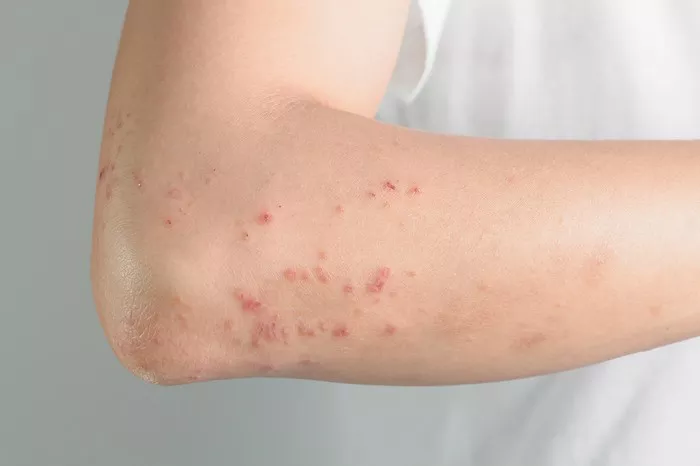Ringworm, a common fungal skin infection, can cause distress due to its appearance and symptoms. Many people notice changes in the color and texture of their skin as the infection heals. One common question is whether ringworm turns black when healing. This article will explain what ringworm is, its healing process, and why color changes might occur.
What is Ringworm?
Ringworm, despite its name, is not caused by worms. It is a fungal infection caused by dermatophytes, which are fungi that thrive on keratin, a protein found in the skin, nails, and hair. The medical term for ringworm is tinea, and it can appear on different parts of the body, such as the scalp (tinea capitis), body (tinea corporis), feet (tinea pedis or athlete’s foot), and groin (tinea cruris or jock itch).
Ringworm often appears as a red, circular, and scaly patch with a raised border. The center of the patch may appear clear or less inflamed, giving it a ring-like appearance. Symptoms include itchiness, redness, and discomfort.
The Healing Process of Ringworm
Treating ringworm effectively involves the use of antifungal medications, either topical or oral. Over-the-counter creams like clotrimazole or prescription antifungals like terbinafine are commonly used. Healing usually begins within a few days to weeks of treatment, depending on the severity of the infection and its location.
The healing process can involve several stages:
Reduction in redness: The intense red color of the rash may fade as inflammation decreases.
Drying and flaking: The infected area may become dry and start to flake as the skin repairs itself.
Change in texture: The raised, scaly border often flattens as the infection subsides.
Color changes: The affected skin may darken, lighten, or develop spots during and after healing.
Why Does Skin Turn Black During Healing?
Skin color changes during healing are a natural response to inflammation and injury. However, the specific reasons for black or dark discoloration can vary.
Post-inflammatory hyperpigmentation (PIH): PIH is a common condition that occurs when the skin produces excess melanin in response to inflammation. After ringworm clears, the affected area may appear darker than the surrounding skin. This discoloration is more noticeable in individuals with darker skin tones but can happen to anyone.
Scarring: If the ringworm infection was severe or left untreated for a long time, the healing process might result in scarring. Scars can sometimes appear dark or black depending on the person’s natural skin tone.
Residual fungal remnants: In some cases, remnants of the fungal infection may linger in the upper layers of the skin, causing discoloration even after the infection has resolved. This is not a sign of active infection but rather the skin taking time to fully recover.
Secondary infections: Scratching the ringworm lesion can introduce bacteria to the wound, causing a secondary infection. This can darken the healing area and delay the process.
Does Black Color Always Indicate Healing?
Not necessarily. While darkening can be a part of the healing process, other factors may also cause discoloration:
Mistaken diagnosis: Some conditions, such as eczema, psoriasis, or even skin cancer, can mimic ringworm and cause dark patches.
Incorrect treatment: Using the wrong medication or delaying treatment can worsen the infection and lead to unusual skin changes.
Persistent infection: If the ringworm has not fully cleared, the lesion might not be healing properly.
If you are unsure about the changes in your skin, consult a dermatologist for an accurate diagnosis.
How Long Does the Dark Discoloration Last?
Dark patches caused by post-inflammatory hyperpigmentation often fade over time. The duration can vary based on:
Skin type: Darker skin tones may take longer to return to their normal color.
Location: Areas with more friction, like the groin or underarms, might take longer to heal.
Care: Proper moisturizing, sun protection, and avoiding irritants can speed up recovery.
In general, PIH may take a few weeks to several months to fade completely. For some individuals, it may take longer.
Tips for Managing Skin Discoloration
Here are some ways to care for your skin as it heals:
Use sun protection: UV exposure can worsen pigmentation changes. Apply sunscreen with at least SPF 30 to the affected area if it is exposed to the sun.
Avoid scratching: Scratching can delay healing and increase the risk of scarring or secondary infection.
Hydrate your skin: Use a gentle moisturizer to keep the skin hydrated and promote faster healing.
Gentle exfoliation: After the infection has completely cleared, gentle exfoliation can help remove dead skin cells and improve the appearance of dark spots. Be cautious not to irritate the skin.
Topical treatments: Products containing ingredients like vitamin C, niacinamide, or retinoids can help fade dark spots. Consult a dermatologist before starting any new treatment.
When to See a Doctor
If you notice unusual changes in your skin during or after ringworm treatment, seek medical advice. Warning signs include:
- Persistent redness, swelling, or itching
- Dark patches that do not fade over time
- Development of new symptoms, such as pain or pus
- Spread of the infection to other areas
Prevention Tips
Preventing ringworm and its complications can save you time and discomfort. Follow these simple tips:
- Keep your skin clean and dry.
- Avoid sharing personal items like towels, clothing, or combs.
- Wear breathable fabrics and avoid tight clothing.
- Treat pets for fungal infections, as they can transmit ringworm to humans.
- Use antifungal powders or sprays in communal areas like gyms or pools.
Conclusion
Ringworm healing can involve changes in skin color, including darkening. In most cases, this is a natural part of recovery due to post-inflammatory hyperpigmentation or scarring. However, persistent or unusual discoloration may warrant a visit to a dermatologist to rule out other conditions or complications. With proper care and treatment, most cases of ringworm resolve without long-term effects.
Related topics:
























